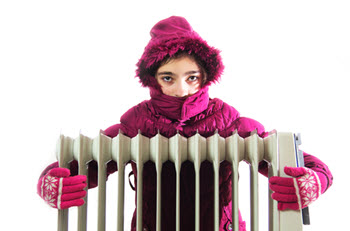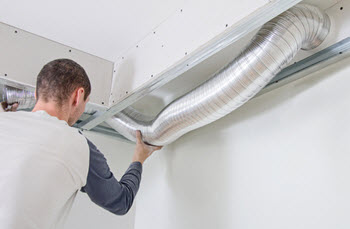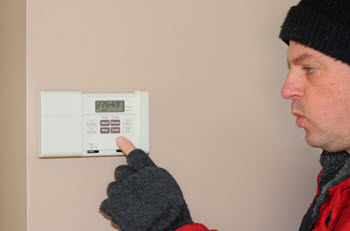Why Is It Hotter Upstairs Than Downstairs?
 A heating system that maintains every room at the same temperature is the ideal situation. However, in reality, it’s typical for rooms on lower levels to be slightly cooler than those in a building’s upper levels.
A heating system that maintains every room at the same temperature is the ideal situation. However, in reality, it’s typical for rooms on lower levels to be slightly cooler than those in a building’s upper levels.
For example, in your home, you have probably noticed that it is often hotter upstairs than it is downstairs. This problem is common, and it frequently leads to people on the lower level feeling quite comfortable, while those upstairs often feel too warm. Do you ever wonder why this disparity in comfort and temperature occurs? Well, keep reading to discover the answer.
Georgetown HVAC Companies: Why Is It Hotter Upstairs Than Downstairs?
It’s not unusual for temperatures to drop below freezing during the winter. Therefore, it is important to schedule a heating service before the start of the cold season. You should also clean your air ducts and furnace. Be sure to replace air filters to help increase the energy efficiency of your heating system. All of these tasks help boost overall performance. A simple tune-up of your heating system can also improve indoor air quality.
You should always hire a qualified service technician with experience in the HVAC industry for any furnace maintenance. While your heating system will work hard to maintain an indoor temperature that is comfortable, even during the coldest months of winter, it is imperative that you take steps to ensure that the temperature upstairs is just as comfortable as it is downstairs.
What causes temperature differences in various areas of your home?
In Two-Story Houses, Warm Air Rises
As your heating system warms the cold air, the volume of the air increases and this reduces its density. The result of this change in the air is that the cold, denser air, displaces the warm air as it pushes it upwards. When you live in a home with two or more levels, heated air will naturally rise up to the higher levels of your home. Consequently, rooms located upstairs will be warmer than rooms in downstairs areas.
Temperature Imbalances Can Be Caused By Poor Ductwork Sizing
 If you have ductwork in your house that is an inappropriate size or that has a poor design, you can end up with rooms that don’t get proper airflow. For example, if the ducts leading to upper levels in your home are bigger than the ducts for lower levels, it’s possible that the upstairs will end up getting more heated air, leading to different temperatures in your home.
If you have ductwork in your house that is an inappropriate size or that has a poor design, you can end up with rooms that don’t get proper airflow. For example, if the ducts leading to upper levels in your home are bigger than the ducts for lower levels, it’s possible that the upstairs will end up getting more heated air, leading to different temperatures in your home.
Upstairs Areas Lack Exterior Doors
One reason why it might be colder downstairs than it is upstairs is that you have a home with the main entrance located on the downstairs level. Every time you open this door, you let cold air in while allowing heated air to escape.
Likewise, merely opening a backdoor can lead to the loss of precious heated air. This can be a big reason why your home stays hotter upstairs than it does downstairs.
Your Thermostat Could Be Improperly Located
 The thermostat is the device responsible for regulating your furnace. It turns your furnace off and on to maintain the desired indoor temperature. If the thermostat senses that the air temperature has fallen below the temperature you have set, it will switch on the furnace to generate more heated air into your home.
The thermostat is the device responsible for regulating your furnace. It turns your furnace off and on to maintain the desired indoor temperature. If the thermostat senses that the air temperature has fallen below the temperature you have set, it will switch on the furnace to generate more heated air into your home.
Many thermostats are located in the main floor living room, but this means that it won’t be effective in controlling whether upper levels of your home are comfortable. For example, an upstairs bedroom might be already at your desired temperature. However, with a thermostat that is downstairs, an area that is naturally cooler, the thermostat reads a lower temperature, triggering the furnace to turn on the heat. Consequently, this makes the upstairs bedroom get hotter than desired.
How To Keep Your Home At An Even Temperature
 An effective way to maintain your home at an even temperature is to use zoned heating. To do this, you’ll need to have thermostats installed in different areas or zones in your home. A zoned system will ensure your heating system heats cooler areas of your home independently from the warmer areas. It can turn the heat on only in the areas that have dropped below your desired temperature without heating areas that have already reached your preset temperature.
An effective way to maintain your home at an even temperature is to use zoned heating. To do this, you’ll need to have thermostats installed in different areas or zones in your home. A zoned system will ensure your heating system heats cooler areas of your home independently from the warmer areas. It can turn the heat on only in the areas that have dropped below your desired temperature without heating areas that have already reached your preset temperature.
The installation of a zoned heating system can effectively remedy problems with temperature variations. It’s important to hire a qualified heating contractor to inspect the heating system and properly identify the exact problem. When they identify the issue, the experienced heating contractor can offer you the appropriate solutions. They can ensure that you have a heating system that is efficient and functions at its best.
Conclusion
At Townsend Energy, we have technicians who are NATE certified to provide you with quality HVAC services.
We offer exceptional heating and cooling services, including tune-ups, installation, repairs, and replacement of HVAC equipment. We have a team of qualified contractors who have the expertise and experience to provide quality service to keep your HVAC system working the way it should.
If you have areas that are hard to heat or cool, we can determine the best solution to help create even temperature throughout your house. Additionally, Townsend Energy offers competitive prices for all of the HVAC services that we offer. Give us a call today and schedule your appointment. We provide free in-home estimates.
Some of the areas that we service include Boxford, Byfield, Georgetown, Groveland, Rowley, and these zip codes 01921, 01922, 01833, 01834, 01969 as well as all surrounding areas in Essex County, Massachusetts.
Click here to contact us now or you can call us at (800) 888-2888 to find out more!